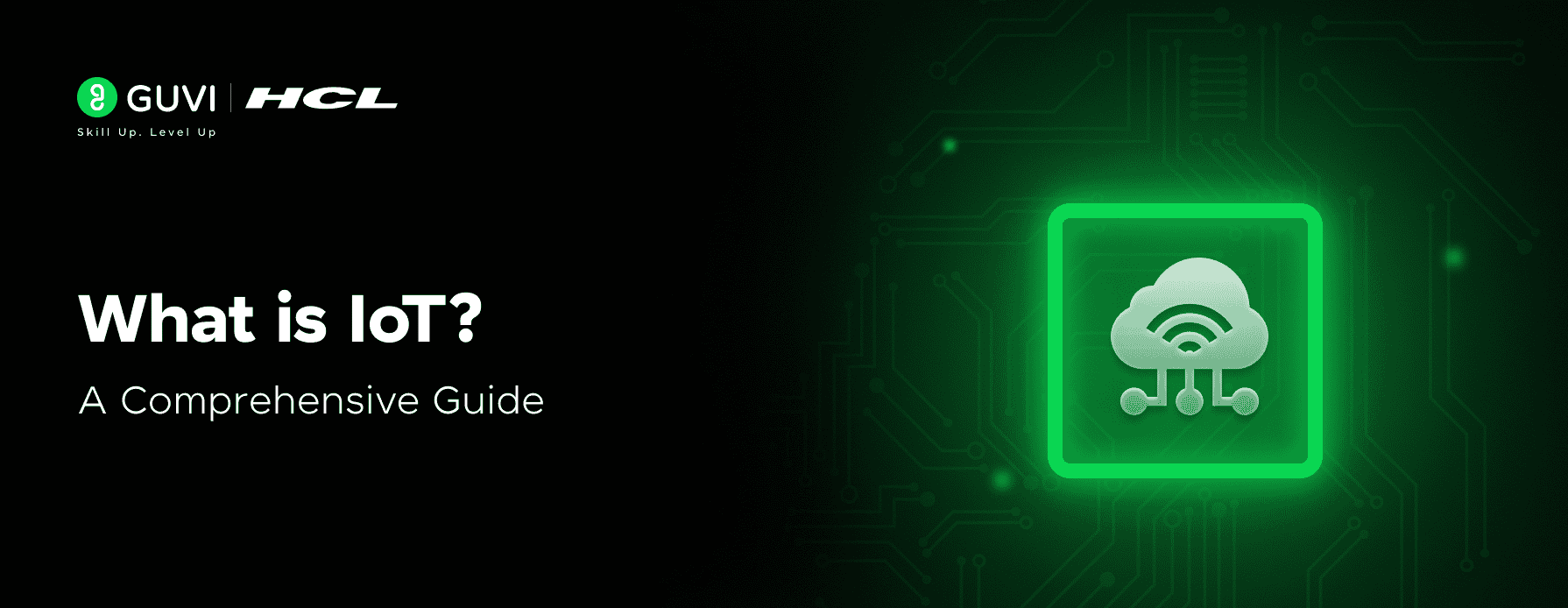
What is IoT? A Comprehensive Guide [2025]
Oct 13, 2025 7 Min Read 3322 Views
(Last Updated)
Have you seen those talking robots delivering food at restaurants in China? Amazing how a machine is just walking around and talking smartly, right? Well, it’s all thanks to the Internet of Things (IoT) that has revolutionized our relationship with technology since its humble beginnings with a simple internet-connected toaster in 1990.
Today’s sophisticated network connects over 35 billion devices worldwide. Many people use IoT devices in their daily lives without even knowing it. Smart home lighting controlled through smartphones and remote patient health monitoring systems are just two examples of IoT technology at work.
And if you’re looking to build a career in this wonderful field, I understand it can be confusing. Hence, this piece will help you grasp the fundamentals of IoT, what IoT is, understand how these devices function, and discover their growing significance in our everyday lives.
Table of contents
- What is IoT?
- The difference between Regular devices and IoT devices
- How Does IoT Work?
- Key Technologies Behind IoT
- 1) Artificial Intelligence
- 2) Connectivity Protocols
- 3) Edge Computing
- 4) Cloud Computing
- Applications of IoT
- 1) Consumer IoT
- 2) Industrial IoT (IIoT)
- 3) Healthcare IoT
- 4) Smart Cities & Transportation
- Pros and Cons of IoT
- IoT Challenges & Security Risks
- 1) Cybersecurity Threats
- 2) Privacy Issues
- 3) Interoperability Problems
- 4) Scalability
- Future of IoT
- Concluding Thoughts…
- FAQs
- Q1. How much do you earn in IoT?
- Q2. What is the Internet of Things (IoT)?
- Q3. What are some common applications of IoT in daily life?
- Q4. How is IoT expected to evolve shortly?
What is IoT?
IoT represents a fundamental change in how devices interact with our world and each other. IoT gives the power of internet connectivity to everyday objects beyond standard computing devices. These objects can collect, analyze, and share data without human intervention.
![What is IoT? A Comprehensive Guide [2025] 1 What is](https://www.guvi.in/blog/wp-content/uploads/2025/04/What-is-IoT_@2x.png)
The formal definition is that the Internet of Things (IoT) describes a network of physical objects—”things”—embedded with sensors, software, and other technologies that connect and share data with other devices and systems over the internet.
These internet-enabled objects range from simple household items to sophisticated industrial equipment. They create an interconnected ecosystem that brings the physical and digital worlds together.
The difference between Regular devices and IoT devices
IoT devices differ from traditional network devices (like smartphones, computers, and tablets) in their origin and purpose. IoT devices work autonomously, often without direct human intervention, making them essential to creating smart environments. We can define IoT devices as “equipment that contains embedded technology to sense or interact with their environment and communicate with the internet”.
Traditional networks mainly enable communication between computing endpoints like servers, computers, and mobile devices in the digital world. These devices need human interaction to work properly, while IoT devices run independently once configured. Go through this table for a better understanding:
| Characteristic | Traditional Devices | IoT Devices |
| Primary purpose | Computing and communication | Sensing and automation |
| Human interaction | Requires direct interaction | Often works autonomously |
| Content creation | Created by humans | Generated by sensors |
| Content consumption | Pull-based (by request) | Push-based (notifications) |
| Value delivery | Answers questions | Enables timely actions |
| Design focus | General computing | Task-specific efficiency |
How Does IoT Work?
Smart devices work through a sophisticated yet simple system that powers IoT functionality. IoT creates a connection between the physical and digital worlds through continuous sensing, communicating, and responding, unlike traditional computing systems.
![What is IoT? A Comprehensive Guide [2025] 2 How Does IoT](https://www.guvi.in/blog/wp-content/uploads/2025/04/How-Does-IoT-Work_@2x.png)
Every IoT ecosystem works through four basic components that function together, whatever its complexity:
1) Sensors/Devices: These are the “things” in the Internet of Things—physical objects embedded with sensors that collect data from their environment. Sensors detect changes in temperature, pressure, humidity, light, motion, or almost any physical parameter. Devices of all sizes exist, from simple temperature monitors to complex industrial equipment. To name just one example, see how a smart thermostat uses temperature sensors to monitor your home, while industrial sensors track machine performance in a factory.
2) Connectivity: IoT devices need ways to send their collected information. Connectivity means different methods devices use to connect and communicate, including WiFi, Bluetooth, cellular networks, or specialized IoT protocols like LPWAN. Your connectivity choice depends on power consumption, range, and bandwidth needs.
3) Data Processing: Raw data becomes valuable only after analysis. This component uses algorithms and software to transform collected data into practical insights. Processing happens locally (edge computing) or in the cloud, based on what the application needs. A smart factory might process temperature data and adjust cooling systems automatically when readings get too high.
4) User Interface: People interact with IoT systems through mobile apps, websites, or dashboards. The interface shows processed information and lets users control the system from anywhere. Some systems can take automated actions based on preset rules without human input.
Key Technologies Behind IoT
Smart devices rely on several powerful technologies that work together. These technologies are the foundations that make IoT both possible and valuable. Let’s get into how your smart devices actually become “smart.”
![What is IoT? A Comprehensive Guide [2025] 3 Key Technologies Behind](https://www.guvi.in/blog/wp-content/uploads/2025/04/Key-Technologies-Behind-IoT@2x.png)
1) Artificial Intelligence
AI acts as the brain of modern IoT systems and changes standard IoT networks into intelligent systems that make decisions on their own. AI helps machines find patterns in data and make predictions. To cite an instance, manufacturing plants use AI to analyze machine sensor data and predict equipment failures before they happen. This cuts down on expensive downtime by a lot.
2) Connectivity Protocols
Connectivity protocols are the languages IoT devices use to talk to each other and central systems. These protocols control how systems package, send, and receive data across networks.
Home IoT systems usually use WiFi with MQTT or HTTP protocols. Industrial applications often need specialized protocols to get better reliability and efficiency.
3) Edge Computing
Edge computing solves a big problem in IoT by processing data near its source instead of sending everything to distant servers.
Remote locations with spotty internet benefit from edge computing. The same goes for applications that need instant responses. Factories, hospitals, and self-driving systems rely on edge computing to keep running even when cloud connections fail.
4) Cloud Computing
Cloud computing provides the flexible foundation that supports large IoT deployments. IoT devices generate huge amounts of data. The cloud offers storage and processing power that’s practically unlimited.
Cloud platforms usually come with complete IoT management solutions. These include device registration, security features, data storage, and analytics tools. Many IoT applications use both edge computing for instant processing and cloud computing for storage and complex analytics.
These four technologies—AI, connectivity protocols, edge computing, and cloud computing—are the foundations that make IoT systems powerful, efficient, and crucial to modern life. Their ongoing evolution will expand IoT’s capabilities and enable more sophisticated applications.
Applications of IoT
IoT technology has moved beyond theory into real-life applications that reshape the scene in many sectors. Connected devices and informed decisions now shape industries and our daily lives. Let’s look at how IoT works in different areas and what value it brings.
![What is IoT? A Comprehensive Guide [2025] 4 Applications of](https://www.guvi.in/blog/wp-content/uploads/2025/04/Applications-of-IoT@2x.png)
1) Consumer IoT
Consumer IoT includes connected devices made for personal use that improve convenience and streamline processes in daily life. This category has smart wearables, home automation systems, and entertainment devices that collect and share data through internet connections.
Rising disposable incomes, increased urbanization, and people’s need for convenience to improve their lifestyle propel this growth.
Popular consumer IoT applications include:
- Smart home devices like internet-enabled appliances, smart light switches, air quality monitors, locks, voice controllers, and smoke alarms work together in a connected system.
- Personal healthcare devices track wellness metrics like body temperature, respiration rate, pulse rate, and blood pressure. These devices connect with smartphones so users can check their health conditions in real-time.
2) Industrial IoT (IIoT)
Industrial IoT connects machines, cloud computing, analytics, and people to boost performance and productivity in industrial processes. Companies use IIoT to digitize operations, change business models, and cut waste while making processes more efficient.
Industrial companies in manufacturing, energy, agriculture, transportation, and utilities run IoT projects. Key IIoT applications include:
- Predictive maintenance watches equipment status to spot potential breakdowns before they affect production. This approach extends equipment life, improves worker safety, and optimizes supply chains. ABB’s connected sensors monitor their robots’ maintenance needs across five continents and trigger repairs before parts fail.
- Asset condition monitoring tracks machines and equipment to measure asset performance. Companies make use of IoT data like temperature, vibration, and error codes to get the most from their assets.
3) Healthcare IoT
The Internet of Medical Things (IoMT) brings IoT technologies into healthcare through medical wearables and other connected devices that collect and analyze patient data. These systems work well in various healthcare scenarios, from early diagnostics to stopping pandemics.
Major healthcare IoT applications include:
- Remote patient monitoring (RPM) measures health parameters and links the data with clinical systems continuously. Clinicians can see past and current data about a patient’s health and get alerts about possible dangers. Studies show that remote patient monitoring IoT devices can spot falls with 95% accuracy.
- Smart implantable devices such as glucose monitoring systems go under a diabetic patient’s skin. These sensors alert patients’ phones when glucose levels drop too low and save historical data to check later.
4) Smart Cities & Transportation
Smart cities make use of information and IoT to improve life quality, urban operations, and services. IoT helps cities respond better to citizens’ needs while cutting costs and environmental impact by connecting infrastructure, vehicles, and public services.
Primary smart city applications include:
- Smart transportation systems use IoT sensors to improve traffic flow, reduce congestion, and make public transit work better. Singapore’s Land Transport Authority’s Intelligent Transport Systems uses IoT technologies to watch and manage traffic through sensors and cameras.
- Smart waste management systems create cleaner, healthier living in sustainable cities. IoT-based waste management saves fuel, guides container pickup, and removes toxic waste before it pollutes cities.
IoT technology’s advancement will make these applications more sophisticated and common as they become part of our daily lives and business operations.
Pros and Cons of IoT
IoT, like any new technology, brings both good and bad things to the table. You need to understand both sides to make smart choices about using these connected devices in your life or business.
Here’s a simple breakdown of IoT’s main pros and cons:
| Advantages of IoT | Disadvantages of IoT |
| Automation & Efficiency IoT automates repeated tasks and saves time and effort. This makes systems work better with less human input and gets more done. | Remote Monitoring IoT lets you check and control systems from anywhere. You can keep an eye on your home security system remotely, which gives you peace of mind. |
| System Complexity systems can get tricky with many connected: devices that need different setups. One small problem can mess up the whole system, making fixes hard to find. | Data Insights IoT gathers lots of useful data that helps make better decisions. You can watch and analyze things as they happen, giving you insights you couldn’t get before. |
| Cost Savings IoT cuts running costs through smart maintenance and better use of resources. Smart power management alone saves money by controlling energy use automatically. | Compatibility Issues With no worldwide standards, devices from different makers often don’t work well together. Users sometimes have to stick to one brand’s products. |
| Job Displacement automation might mean fewer jobs for unskilled workers. But IoT also creates new jobs for people with technical skills. | Job Displacement More automation might mean fewer jobs for unskilled workers. But IoT also creates new jobs for people with technical skills. |
| Healthcare Benefits Doctors can spot health problems early by watching patients remotely. Research shows IoT devices spot patient falls with 95% accuracy. | Technology Dependency Relying too much on IoT can cause problems during power cuts or internet outages. People might also forget how to do simple tasks on their own. |
| Environmental Impact Smart systems use resources better and waste less. Smart lights and thermostats can cut energy use by a lot. | Learning Curve Setting up and using IoT devices needs tech knowledge that many people don’t have. This can be tough for those who aren’t tech-savvy. |
IoT’s future looks bright as long as we tackle these challenges carefully. The good usually outweighs the bad when IoT is set up thoughtfully with good security measures in place.
IoT Challenges & Security Risks
IoT has amazing potential, but its adoption faces several major hurdles. Security flaws and setup challenges can derail even the most promising IoT projects without proper handling.
![What is IoT? A Comprehensive Guide [2025] 5 IoT Challenges Security](https://www.guvi.in/blog/wp-content/uploads/2025/04/IoT-Challenges-Security-Risks@2x.png)
1) Cybersecurity Threats
IoT devices lack built-in security, which makes them easy targets for attacks. As IoT devices connect to the internet, they become prime targets for cyberattacks. Many IoT devices have weak security measures, making them vulnerable to malware, hacking, and denial-of-service (DoS) attacks.
The 2016 Mirai botnet attack is a prime example, where thousands of compromised IoT devices were used to launch a massive cyberattack, disrupting major internet services worldwide.
Also read about What is Cybersecurity?
2) Privacy Issues
IoT devices collect vast amounts of user data, including personal and behavioral information. If this data is not properly encrypted or secured, it can lead to unauthorized access and misuse.
For example, smart home assistants continuously listen for voice commands, raising concerns about data privacy and unauthorized eavesdropping. Stricter data protection regulations like GDPR and CCPA aim to address these concerns, but challenges remain in enforcing them across different IoT ecosystems.
3) Interoperability Problems
The lack of standardization among IoT devices and platforms creates compatibility issues. Different manufacturers use proprietary protocols and communication standards, making it difficult for devices from different brands to interact seamlessly. This fragmentation hinders the full potential of IoT ecosystems, especially in smart homes and industrial IoT, where multiple devices need to work together efficiently.
4) Scalability
As IoT networks grow, managing thousands (or even millions) of connected devices becomes increasingly complex. Issues like network congestion, data overload, and inefficient resource allocation can degrade performance.
Moreover, securing a large-scale IoT infrastructure becomes challenging, as each additional device presents a new potential vulnerability. Edge computing and AI-driven automation are emerging solutions to help scale IoT networks more efficiently.
Future of IoT
IoT continues to rise rapidly. Several key trends shape its future path as we look toward 2025 and beyond. IoT will affect industries and daily life in dramatic ways. Let’s discuss a little bit of the future:
- AI integration acts as a major catalyst that stimulates IoT growth. These combined technologies help devices do more than just connect – they can make decisions in real-time. Companies can create smarter strategies and give customers uniquely personalized experiences as this integration grows deeper.
- 5G networks play a vital role in IoT development. The higher bandwidth, lower latency, and support for more connected devices make previously impossible applications a reality. For example, hospitals worldwide now use 5G to monitor patients remotely. This makes healthcare delivery more efficient by a lot.
IoT started with consumer products, moved to industrial changes, and ended up revolutionizing healthcare. The future points toward smarter, connected, and sustainable systems in every part of modern life.
If you want to begin your IoT learning journey and build a career in this cutting-edge field, the Essentials of IoT Course by HCL GUVI is the perfect starting point. This hands-on program covers IoT fundamentals, hardware & software integration, and real-world applications, equipping you with the skills needed for IoT development, smart automation, and embedded systems careers.
Concluding Thoughts…
Well, we can surely conclude now that IoT stands as one of the biggest technological changes of our time. Billions of connected devices bring intelligence and automation to everyday objects. This reshapes homes, industries, and cities in ways we never imagined.
IoT brings great benefits through automated tasks, evidence-based insights, and reduced costs. The biggest problem lies in security and privacy concerns. Success depends on a careful approach to IoT adoption with strong security and clear goals.
As IoT grows and evolves, it will affect our daily lives more than ever. This makes it a key technology that everyone should learn about and understand. Hence, I hope this article has proven to be the perfect starting point you needed to get into IoT!
FAQs
Q1. How much do you earn in IoT?
The average salary for IoT professionals in India ranges from ₹5–12 LPA for entry to mid-level roles, while experienced professionals can earn ₹20 LPA or more.
Q2. What is the Internet of Things (IoT)?
The Internet of Things refers to a network of physical objects embedded with sensors, software, and connectivity features that allow them to collect and exchange data over the Internet. These objects range from everyday household items to sophisticated industrial equipment, creating an interconnected ecosystem that bridges the physical and digital worlds.
Q3. What are some common applications of IoT in daily life?
IoT applications are widespread in daily life, including smart home devices (like thermostats, lights, and security systems), wearable health trackers, connected cars, and smart city infrastructure such as traffic management systems and waste collection optimization.
Q4. How is IoT expected to evolve shortly?
The future of IoT is likely to see deeper integration with AI, expansion through 5G networks, increased use of edge computing for faster data processing, and growth in space-based IoT networks. By 2030, it’s projected that there will be over 40 billion connected IoT devices, driving significant economic value across various industries.



















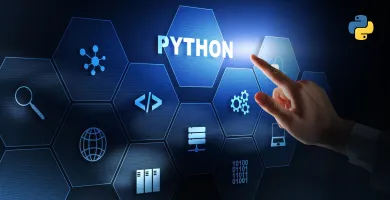



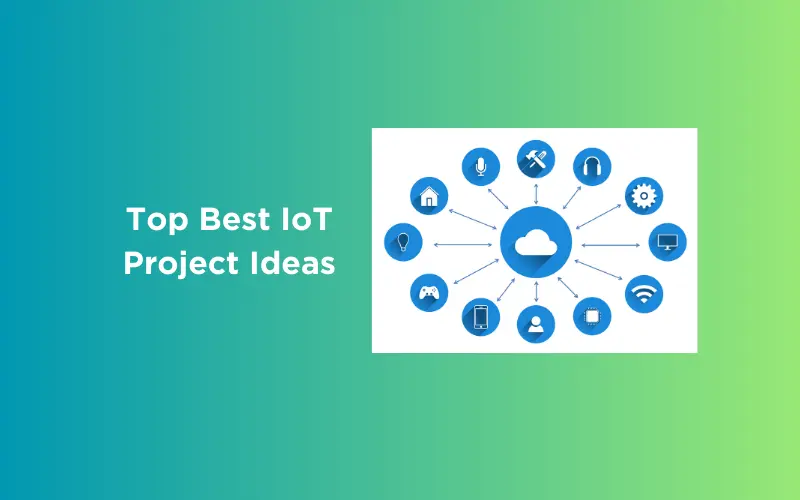

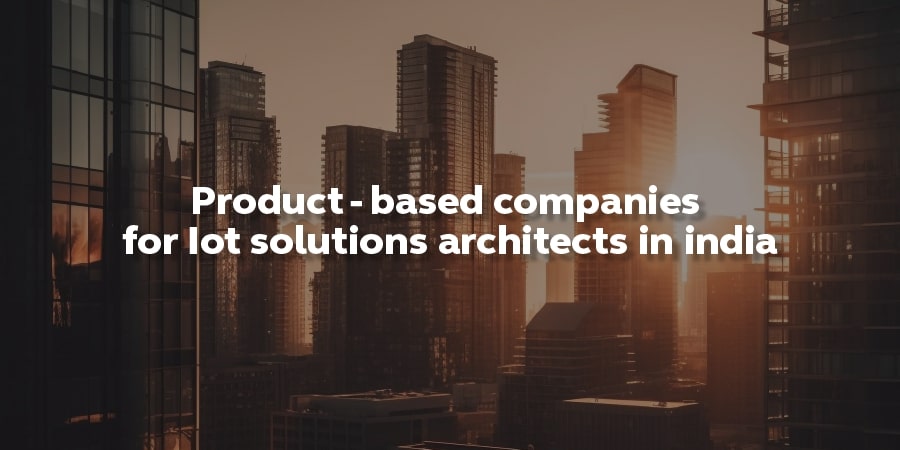
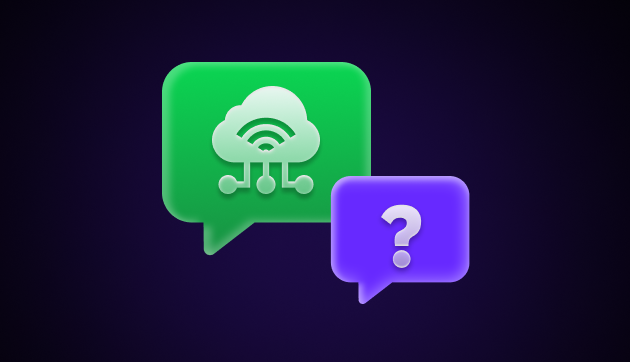
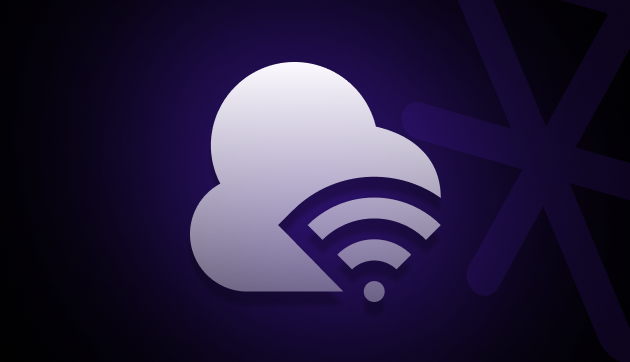




Did you enjoy this article?